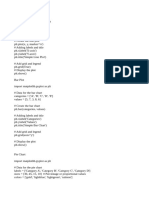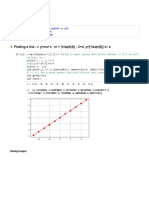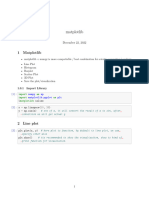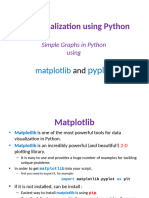0 ratings0% found this document useful (0 votes)
2 viewsMatplotlib_Examples_With_Code_Side_by_Side
The document provides code examples for creating various types of plots using Matplotlib, including line plots, scatter plots, bar plots, histograms, box plots, pie charts, heatmaps, and 3D plots. Each section includes the necessary code to generate the respective plot along with titles and axis labels. The examples demonstrate the versatility of Matplotlib for visualizing data in different formats.
Uploaded by
Bassel EissaCopyright
© © All Rights Reserved
Available Formats
Download as PDF, TXT or read online on Scribd
0 ratings0% found this document useful (0 votes)
2 viewsMatplotlib_Examples_With_Code_Side_by_Side
The document provides code examples for creating various types of plots using Matplotlib, including line plots, scatter plots, bar plots, histograms, box plots, pie charts, heatmaps, and 3D plots. Each section includes the necessary code to generate the respective plot along with titles and axis labels. The examples demonstrate the versatility of Matplotlib for visualizing data in different formats.
Uploaded by
Bassel EissaCopyright
© © All Rights Reserved
Available Formats
Download as PDF, TXT or read online on Scribd
You are on page 1/ 8
Line Plot
Code:
import matplotlib.pyplot as plt
x = [1, 2, 3, 4, 5]
y = [2, 3, 5, 7, 11]
plt.plot(x, y)
plt.title('Line Plot')
plt.xlabel('X-axis')
plt.ylabel('Y-axis')
plt.show()
Scatter Plot
Code:
import matplotlib.pyplot as plt
x = [1, 2, 3, 4, 5]
y = [2, 3, 5, 7, 11]
plt.scatter(x, y)
plt.title('Scatter Plot')
plt.xlabel('X-axis')
plt.ylabel('Y-axis')
plt.show()
Bar Plot
Code:
import matplotlib.pyplot as plt
categories = ['A', 'B', 'C', 'D']
values = [3, 7, 8, 5]
plt.bar(categories, values)
plt.title('Bar Plot')
plt.xlabel('Categories')
plt.ylabel('Values')
plt.show()
Histogram
Code:
import matplotlib.pyplot as plt
import numpy as np
data = np.random.randn(1000)
plt.hist(data, bins=30)
plt.title('Histogram')
plt.xlabel('Value')
plt.ylabel('Frequency')
plt.show()
Box Plot
Code:
import matplotlib.pyplot as plt
import numpy as np
data = [np.random.randn(100) for _ in range(5)]
plt.boxplot(data)
plt.title('Box Plot')
plt.xlabel('Dataset')
plt.ylabel('Value')
plt.show()
Pie Chart
Code:
import matplotlib.pyplot as plt
labels = 'A', 'B', 'C', 'D'
sizes = [15, 30, 45, 10]
explode = (0, 0.1, 0, 0) # only "explode" the 2nd slice (i.e. 'B')
plt.pie(sizes, explode=explode, labels=labels, autopct='%1.1f%%',
shadow=True, startangle=140)
plt.title('Pie Chart')
plt.show()
Heatmap
Code:
import matplotlib.pyplot as plt
import numpy as np
data = np.random.rand(10, 10)
plt.imshow(data, cmap='hot', interpolation='nearest')
plt.title('Heatmap')
plt.colorbar()
plt.show()
3D Plot
Code:
import matplotlib.pyplot as plt
from mpl_toolkits.mplot3d import Axes3D
import numpy as np
fig = plt.figure()
ax = fig.add_subplot(111, projection='3d')
x = np.linspace(-5, 5, 100)
y = np.linspace(-5, 5, 100)
X, Y = np.meshgrid(x, y)
Z = np.sin(np.sqrt(X**2 + Y**2))
ax.plot_surface(X, Y, Z, cmap='viridis')
plt.title('3D Plot')
plt.show()
You might also like
- Hands On Data Visualization Using Matplotlib100% (1)Hands On Data Visualization Using Matplotlib7 pages
- Matplotlib Starter: Import As Import As Import AsNo ratings yetMatplotlib Starter: Import As Import As Import As24 pages
- Introduction To Matplotlib Using Python For BeginnersNo ratings yetIntroduction To Matplotlib Using Python For Beginners14 pages
- Study Material For XII Computer Science On: Data Visualization Using PyplotNo ratings yetStudy Material For XII Computer Science On: Data Visualization Using Pyplot22 pages
- Graphs with MATLAB (Taken from "MATLAB for Beginners: A Gentle Approach")From EverandGraphs with MATLAB (Taken from "MATLAB for Beginners: A Gentle Approach")4/5 (2)
- Introduction To Matplotlib Using Python For BeginnersIntroduction To Matplotlib Using Python For Beginners
- Study Material For XII Computer Science On: Data Visualization Using PyplotStudy Material For XII Computer Science On: Data Visualization Using Pyplot
- Graphs with MATLAB (Taken from "MATLAB for Beginners: A Gentle Approach")From EverandGraphs with MATLAB (Taken from "MATLAB for Beginners: A Gentle Approach")































































